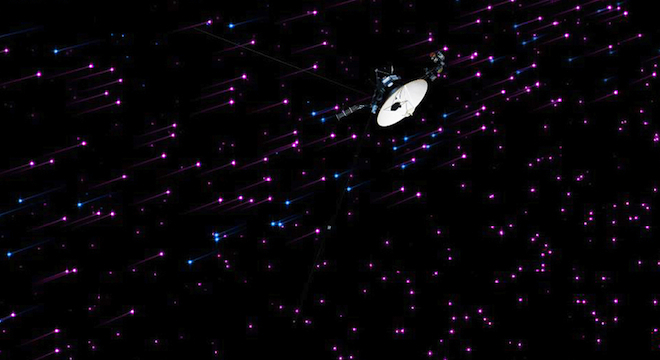We knew this day would come: NASA’s Voyager 1 spacecraft, launched in 1977, today still traveling away from Earth at a rate of 35,700 miles-per-hour, has entered into a new region of space at the end of the solar system, NASA announced on Monday.
“We believe this is the last leg of our journey to interstellar space,” said Voyager’s longstanding project scientist, Ed Stone, who has been in charge of the mission of the spacecraft and its identical twin Voyager 2 since their launches, in a statement published Monday by NASA. “Our best guess is it’s likely just a few months to a couple years away. The new region isn’t what we expected, but we’ve come to expect the unexpected from Voyager.”
Specifically, Stone and NASA scientists have received data from Voyager’s still-functioning instruments that reveals the direction of the magnetic field lines haven’t yet changed to indicate that voyager has left the Solar System.
Yet something else profound has changed, and in ways scientists did not anticipate: The levels of low-energy particles from inside the heliosphere — a bubble of particles extending outward millions of miles from the Sun, which marks the boundary of our Solar System and the beginning of interstellar space. The change also came at the same time as another shift, this one in the level of high-energy particles coming from outside the Solar System.
Specifically, beginning in late July, the number of low-energy particles began to dip as the number of high-energy particles increased. While this was expected, as the Sun’s particles are dissipating into outer space and cosmic rays streaming in and replacing them, what followed was not: The two types of particles increased and decreased over the course of several days and weeks, lapping and receding “like an ocean tide” according to NASA, until finally, on August 25, Voyager appeared to have entered a completely new region for good. Check out the changes in the levels of the two respective particles in the following animated GIF graph from NASA (wait a few seconds for animations to move):

This new region has been dubbed “the magnetic highway,” because it is where it is believed the Sun’s magnetic field lines run into those separate lines in interstellar space.
However, NASA still believes that Voyager remains within the very final reaches of the Sun’s particles, an area called the heliosheath, and will be for the near future. NASA is looking for a tell-tale sign that the magnetic lines have switched direction to indicate that the spacecraft has left our home star system for good. Check out the following illustration published by NASA Monday to indicate the difference in the magnetic field directions from Interstellar space (black lines) and those from the Sun (white lines):

Currently, Voyager is some 11 billion miles away from the Sun, with its signal taking about 17 hours to get back to Earth. Its nuclear-powered plutonium 238 batteries are expected to keep all the instruments functioning properly until 2020, when NASA will have to begin shutting off instruments one-by-one. The craft will go completely silent in 2025.
Even then, the craft will sail on as the first ambassador of humanity to the wider Universe, a gold-plated record (the old LP kind) with Earth sounds and images in tow. Meanwhile, its twin probe, Voyager 2, still has yet to reach the magnetic highway at an estimated 9 billion miles from the Sun.






